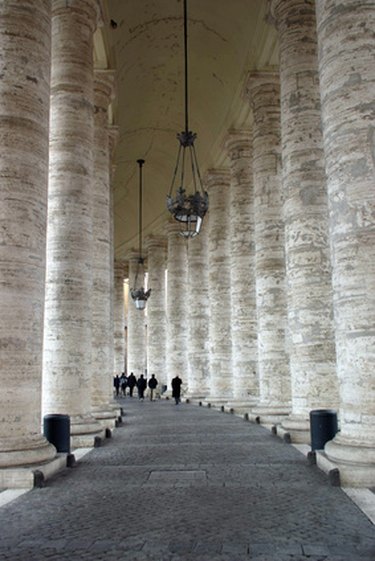
Travertine stone is one of the most widely used stones in today's building industry. Travertine is utilized in both floor and wall tile applications; countertops, patios, building exteriors and outdoor pathways. Commonly mined in Italy and Turkey, travertine stone continues to be a popular import for construction products all over the world.
Background
Video of the Day
Travertine stone is formed by subterranean springs, underground rivers, and various other water sources. These water sources carry mineral elements, specifically calcium carbonate, that build up over several years in the same way stalactites and stalagmites are formed in caves. The newly formed stone is a smooth and hard substance with a porous surface. These pores are the result of gases escaping as the travertine is formed.
Video of the Day
Composition
The structure of travertine stone is uniform with a soft texture and a low hardness, and is nowhere near as dense or hard as granite. Because of these attributes, Travertine stone is fairly easy to mine and process. The density of the stone is also light, allowing for manageable transportation. One of the key characteristics of travertine is the holes and troughs gracing the surface of the stone. These naturally occurring pits give the stone an aged and weathered appearance.
Colors
Travertine colors feature warm earthy tones, and include soft ivories and creams, vibrant shades of golden honey, silvery greens, reds, and deep mocha browns. Travertine is never a solid color due to its veins or bands of contrasting color that run throughout the stone. Therefore, no two stones or tiles are alike.
Finishes
Travertine is available in four major finishes, polished, honed, brushed and tumbled. The type of finish given to the travertine determines how glossy or textured the surface will be. Polished and honed surfaces are smooth, while the brushed and tumbled surfaces are slightly rough and textured. Polished travertine is shiny and smooth to the touch similar to a marble. The most common finish for travertine in residential applications is honed: a flat, smooth feel with a matte finish that mutes reflected light. The resulting tile has a natural but un-textured look.
Care and Maintenance
Because the minerals comprised in travertine stone are highly reactive with acidic solutions, such as orange juice, wine and vinegar, and because travertine stains easily, it is not necessarily the best stone choice for counter tops. Travertine stone is extremely porous. The best way to prevent stains is to treat the surface with a protective sealer which fills in the pores and repels spills on the surface, allowing you time to clean it completely. Travertine stone should only be cleaned with a neutral or mild alkaline-based cleaner.